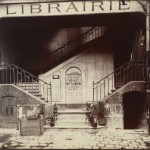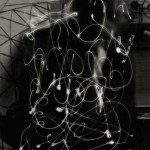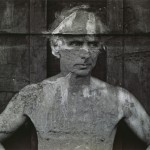by Claire Aasen ’14. In considering what constitutes surrealism, I found all of Atget’s photographs compelling; it is interesting to me that Atget himself did not consider his work “surrealist.” He saw himself as a maker of documents, and it was other, more assuredly surrealist artists like Man Ray who first applied the term to […]
George Platt Lynes, Portrait of Thomas Bacon, ca. 1938
by Andrea Rosen, Curator of Under the Surface. The Portrait of Thomas Bacon exemplifies striking compositional strategies that invite close, slow looking. Between the two poles of the composition—the subject of the portrait in the lower third and a tear in the backdrop at the top—are at first indecipherable marks, which turn out to be the […]
Man Ray, Space Writing (Self-Portrait), 1935
by Andrea Rosen, Curator of Under the Surface. Ever interested in light and movement, Man Ray created Space Writing (Self-Portrait) by opening the shutter of his camera for a prolonged exposure and drawing with a penlight in the air. Man Ray appears only as a dark, blurred figure in the background. His doodled outline, his scribbled […]
Man Ray, Space Writing (Self-Portrait), 1935
by Meg Bunke ’14. This photograph is surprising because of its diminutive size, which is more suggestive of a wallet photo than a photograph displayed in a museum. The photograph’s size makes it seem unassuming next to larger works, despite being taken by such a revered artist. Man Ray uses a long exposure to capture […]
Man Ray, Space Writing (Self-Portrait), 1935
by Jesse Ortiz ’16. Initially, Man Ray’s Space Writing (Self-Portrait) confused me. But as I continued examining the photograph, the layers unraveled—the squiggled “writing” exists in a plane on top of a blurred background. Right away, I saw the hand in the lower right corner. This hand led me to realize that the blurred background […]
Frederick Sommer, Max Ernst, 1946
by Andrea Rosen, Curator of Under the Surface. In Frederick Sommer’s portrait of the surrealist painter Max Ernst, the subject both emerges from and is fused with the textured background, in ways that recall some of Ernst’s own techniques, such as collage and frottage (a rubbing over a textured surface). Sommer achieved this effect through the […]
Frederick Sommer, Max Ernst, 1946
by Jordan Goldberg ’14. I found Frederick Sommer’s portrait of Max Ernst to be extremely compelling. Formed by overlaying the negatives of the portrait of the artist and a photograph of a concrete wall, the composite result displays a confusion of perspective that plays very interestingly with shallowness and depth and creates a disjunction through […]
Frederick Sommer, Max Ernst, 1946
by Walter Wuthmann ’14. At first glance, Frederick Sommer’s photograph, Max Ernst, 1946, looks like an incredibly well-painted mural. Some of the body is wearing away; white streaks carry his skin down the wall like rain damage; the roughness of the wall bubbles up through his skin, implying time and weather and wear. His eyes remain […]



